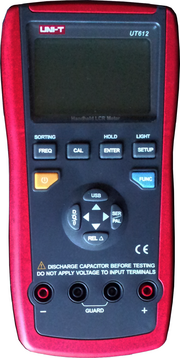Difference between revisions of "UNI-T UT612"
m (UART to USB wires) |
(serial over HID supports CP2110) |
||
| Line 2: | Line 2: | ||
| image = [[File:ut612-front-mugshot.png|180px]] | | image = [[File:ut612-front-mugshot.png|180px]] | ||
| name = UNI-T UT612 | | name = UNI-T UT612 | ||
| status = | | status = supported | ||
| source_code_dir = serial-lcr | | source_code_dir = serial-lcr | ||
| counts = 20000 | | counts = 20000 | ||
| Line 16: | Line 16: | ||
See [[UNI-T UT612/Info]] for more details (such as '''lsusb -v''' output) about the device. | See [[UNI-T UT612/Info]] for more details (such as '''lsusb -v''' output) about the device. | ||
The LCR meter uses the popular ES51919/ES51920 chipset, but with the SiLabs CP2110 USB HID communication chip instead of USB CDC and a regular COM port. | |||
Libsigrok's serial layer supports either type of connection. | |||
== Hardware == | == Hardware == | ||
| Line 145: | Line 146: | ||
[[Category:Device]] | [[Category:Device]] | ||
[[Category:LCR meter]] | [[Category:LCR meter]] | ||
[[Category: | [[Category:Supported]] | ||
Latest revision as of 17:42, 4 June 2019
 | |
| Status | supported |
|---|---|
| Source code | serial-lcr |
| Counts | 20000 |
| IEC 61010-1 | — |
| Connectivity | USB (HID) |
| Measurements | resistance, capacitance, inductance, equivalents |
| Features | autorange, rel, data-hold, auto-poweroff, self-calibration |
| Website | uni-trend.com |
The UNI-T UT612 is a 20000 counts, dual-display, LCR meter with USB/HID connectivity.
See UNI-T UT612/Info for more details (such as lsusb -v output) about the device.
The LCR meter uses the popular ES51919/ES51920 chipset, but with the SiLabs CP2110 USB HID communication chip instead of USB CDC and a regular COM port. Libsigrok's serial layer supports either type of connection.
Hardware
- LCR meter chipset: Cyrustek ES51919 (datasheet)
- HID USB to UART bridge: Silicon Labs CP2110 (datasheet)
The ES51919/51920 chipset is found in other LCR meters, too. The chipset communicates via UART (TX only).
The CP2110 USB serial-over-HID chip resides on a separate breakout board, and is connected to the LCR "mainboard" via a three wire flying cable. Red(!) is GND, green is the meter's TX signal, RX is not connected, yellow is Vcc from USB.
Photos
Protocol
The protocol for the ES51919 was reverse engineered as part of the DER-EE 5000 driver that uses the same chipset. Below is the excerpt from the source code.
Public official documentation does not contain the protocol description, so this is all based on reverse engineering.
Packet structure (17 bytes):
0x00: header1 ?? (0x00)
0x01: header2 ?? (0x0d)
0x02: flags
bit 0 = hold enabled
bit 1 = reference shown (in delta mode)
bit 2 = delta mode
bit 3 = calibration mode
bit 4 = sorting mode
bit 5 = LCR mode
bit 6 = auto mode
bit 7 = parallel measurement (vs. serial)
0x03: config
bit 0-4 = ??? (0x10)
bit 5-7 = test frequency
0 = 100 Hz
1 = 120 Hz
2 = 1 kHz
3 = 10 kHz
4 = 100 kHz
5 = 0 Hz (DC)
0x04: tolerance (sorting mode)
0 = not set
3 = +-0.25%
4 = +-0.5%
5 = +-1%
6 = +-2%
7 = +-5%
8 = +-10%
9 = +-20%
10 = -20+80%
0x05-0x09: primary measurement
0x05: measured quantity
1 = inductance
2 = capacitance
3 = resistance
4 = DC resistance
0x06: measurement MSB (0x4e20 = 20000 = outside limits)
0x07: measurement LSB
0x08: measurement info
bit 0-2 = decimal point multiplier (10^-val)
bit 3-7 = unit
0 = no unit
1 = Ohm
2 = kOhm
3 = MOhm
5 = uH
6 = mH
7 = H
8 = kH
9 = pF
10 = nF
11 = uF
12 = mF
13 = %
14 = degree
0x09: measurement status
bit 0-3 = status
0 = normal (measurement shown)
1 = blank (nothing shown)
2 = lines ("----")
3 = outside limits ("OL")
7 = pass ("PASS")
8 = fail ("FAIL")
9 = open ("OPEn")
10 = shorted ("Srt")
bit 4-6 = ??? (maybe part of same field with 0-3)
bit 7 = ??? (some independent flag)
0x0a-0x0e: secondary measurement
0x0a: measured quantity
0 = none
1 = dissipation factor
2 = quality factor
3 = parallel AC resistance / ESR
4 = phase angle
0x0b-0x0e: like primary measurement
0x0f: footer1 (0x0d)
0x10: footer2 (0x0a)
Resources
- Official UNI-T UT612 related documents (manual, software, ...)
- eevblog.com: Review and tear-down of UNI-T UT612 LCR meter





